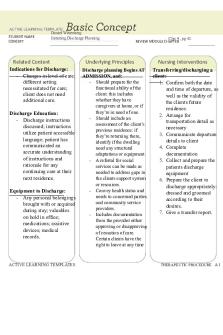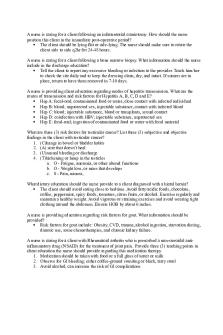VATI Remediation PDF

| Title | VATI Remediation |
|---|---|
| Author | Amanda Brooks |
| Course | Professional Nursing III |
| Institution | Keiser University |
| Pages | 5 |
| File Size | 86.3 KB |
| File Type | |
| Total Downloads | 75 |
| Total Views | 149 |
Summary
VATI Remediation...
Description
A nurse cares for client who presents to the clinic for her first pre-natal visit. The client states her last menstrual period was June 20, 2019. What is the estimated date of delivery (EDD)? March 27, 2020
A nurse is providing client education regarding the advantages and disadvantages of intrauterine devices. What information should the nurse include? Advantages of an IUD are that an IUD can maintain effectiveness for 1-10 years; contraception can be reversed; safe for breastfeeding mothers; and is 99% effective in preventing pregnancy. Disadvantages of an IUD are that the IUD can increase the risk of PID, uterine perforation, or ectopic pregnancy; does not protect against STIs; and a client should report to the provider late or abnormal bleeding/spotting, abdominal pain, abnormal or foul-smelling vaginal discharge, fever, chills, change in string length, or if the IUD cannot be located. A nurse is caring for the family of a newborn. What are some interventions the nurse can use to facilitate sibling acceptance of the newborn? Let the sibling be one of the first to see the newborn, provide a gift to give to the sibling, arrange for one parent to spend time with the sibling while the other patient is taking care of newborn.
A client asks the nurse what the difference is between a durable power of attorney for health care and a living will. What should the nurse teach the client to differentiate the two components of advanced directives? A living will is a legal document that expresses the client’s wishes regarding medical treatment in the event the client becomes incapacitated and is facing end-of-life issues. Most state laws include provisions that protect health care providers who follow a living will from liability. A durable power of attorney for health care is a document in which clients designate a health care proxy to make health care decisions for them if they are unable to do so.
What actions should be taken by the nurse when a client decides to leave the facility against medical advice (AMA)? The nurse should have the patient sign an AMA form, she must then notify the provider and document the patient left against AMA in the chart.
Describe the steps a nurse should take when preparing to administer a blood transfusion. Verify physician orders for blood products. Wash hands. If client does not have an IV, perform venipuncture with 18- or 20-gauge catheter. Assess client for allergies or previous reactions to blood. Verify that blood is ready in blood bank. Obtain blood from blood bank and obtain 500 mL bag of normal Saline. In the patient's room, verify with another registered nurse that the following information is correct: Client's name and identification number on blood bank slip match client's identification bracelet and 2 patient identifiers. Blood bank slip and unit of blood contained the same blood type, donor number, and expiration date. Don gloves. Close all clamps on Y-tubing. Insert one spike of Y-tubing into normal saline. Open clamps and prime normal saline arm of tubing, drip chamber with filter and arm of tubing which will spike into unit of blood. Prime rest of IV tubing. Clamp tubing. Gently rotate unit of blood before spiking. Open clamp on normal saline and infuse 50 mL slowly, close normal saline clamp. Open clamp on blood, and regulate at keep-open rate. Maintain rate for 15 minutes while staying with client. Obtain vital signs at end of first 15 minutes, and observe client for signs of transfusion reaction per institution protocol. Reset drip rate to a rate that will allow transfusion to be completed within 4 hours, If client has stable vital signs and no signs of transfusion reaction, continue to monitor vital signs hourly and client response to transfusion. Complete transfusion by flushing line with normal saline, clamping tubing, and disconnecting. Obtain set of vital signs at end of transfusion. Complete transfusion record and place in chart. Dispose of equipment per facility protocol. Complete documentation date, type, and identification number of product; time started and ended, and client response. A nurse is assigned to float to a unit she is uncomfortable with. What are acceptable strategies to remedy this situation? The nurse should bring the assignment to charge nurse’s attention. Negotiate assignments and tasks float nurse can most appropriately perform in accordance with experience. Follow chain of command if agreement is not achieved.
A client will undergo an emergency thoracentesis to relieve a tension pneumothorax following a traumatic motor vehicle accident. List three (3) action that are imperative for the nurse to perform prior to the procedure. Ensure the client has signed the informed consent, obtain pre-procedure xray to locate pleural effusion and to determine needle insertion site, position the client sitting upright with arms and shoulders raised and supported on pillows and/or an overbed table and with feet and legs well-supported.
The nurse is caring for a client who is receiving mechanical ventilation via an endotracheal tube. List three (3) nursing action to prevent the development of ventilatorassociated pneumonia. The nurse should use suction to continuously remove subglottic secretions, elevate the head of the bed at least 30 degrees whenever possible, and make sure to use proper handwashing technique before and after contact with the client. A nurse is preparing to administer cefixime 8 mg/kg/day by mouth divided in equal doses every 12 hr to a toddler who weighs 22 lb. The amount available is cefixime suspension 100 mg/5 mL. How many mL should the nurse administer per dose? (Round the answer to the nearest whole number.) 2mL per dose
A nurse is caring for a child with moderate dehydration secondary to an acute gastrointestinal infection. If a client is hypokalemic, when is it considered acceptable to administer potassium replacement? It is considered acceptable to administer a potassium replacement if the serum level is less than 3.0 or less than 3.5 with ECG changes.
A nurse is providing discharge information to the parents of a child with cystic fibrosis. List three (3) important teaching points to cover with the parents.
The nurse should include the importance of taking pancreatic enzymes. Pancreatic enzymes can be swallowed whole or sprinkled on a small amount of food taken at the beginning of a meal. The importance of light to moderate exercise when their child is able to tolerate it, and proper coughing techniques.
A client is taking sodium polystyrene sulfonate. What finding indicates the medication is effective? Sodium polystyrene sulfonate binds to potassium in the GI system often causing diarrhea. The effectiveness is determined by a decreasing serum potassium level. What actions should the nurse expect to implement for a client with Trousseau’s sign? Trousseau's sign is a very specific physical exam finding of hypocalcemia (carpopedal spasm when the blood pressure cuff is inflated). Monitor respiratory rate, effort, and rhythm. Place tracheostomy set at the bedside. Maintain a safe, quiet environment and seizure precaution and assess for areas of possible bleeding. Observe for petechiae and ecchymosis.
A client is administered midazolam to induce conscious sedation. List two (2) nursing actions in client care upon administration of midazolam. Midazolam, a benzodiazepine, can cause respiratory depression and hypotension. The nurse must monitor respiratory (O2 sat, RR) and cardiac function (Blood pressure monitoring, HR ).
Order: 3 mg Available: 2 mg per 6 mL How many mL will be given?
9ml/dose
Where would the nurse place the diaphragm of a stethoscope when auscultating the pulmonic area of the heart? The nurse would auscultate at the second intercostal space, midclavicular line. A client with partial dentures reports mouth pain. What is one (1) intervention the nurse could provide for the client? The nurse should advise the client to rinse their mouth and dentures after each meal....
Similar Free PDFs

VATI Remediation
- 5 Pages

Key points for VATI remediation
- 2 Pages

VATI TEST
- 21 Pages

Leadership Ati Vati
- 10 Pages

Remediation (Hypocalcemia)
- 1 Pages

Remediation riassunto
- 13 Pages

Remediation Nutrition
- 6 Pages

NUR 232 ATI Remediation
- 7 Pages

Discharge Planning Remediation
- 1 Pages

Med-Surg Capstone remediation
- 4 Pages

ATI Remediation
- 9 Pages

Peds ATI Final Remediation
- 3 Pages
Popular Institutions
- Tinajero National High School - Annex
- Politeknik Caltex Riau
- Yokohama City University
- SGT University
- University of Al-Qadisiyah
- Divine Word College of Vigan
- Techniek College Rotterdam
- Universidade de Santiago
- Universiti Teknologi MARA Cawangan Johor Kampus Pasir Gudang
- Poltekkes Kemenkes Yogyakarta
- Baguio City National High School
- Colegio san marcos
- preparatoria uno
- Centro de Bachillerato Tecnológico Industrial y de Servicios No. 107
- Dalian Maritime University
- Quang Trung Secondary School
- Colegio Tecnológico en Informática
- Corporación Regional de Educación Superior
- Grupo CEDVA
- Dar Al Uloom University
- Centro de Estudios Preuniversitarios de la Universidad Nacional de Ingeniería
- 上智大学
- Aakash International School, Nuna Majara
- San Felipe Neri Catholic School
- Kang Chiao International School - New Taipei City
- Misamis Occidental National High School
- Institución Educativa Escuela Normal Juan Ladrilleros
- Kolehiyo ng Pantukan
- Batanes State College
- Instituto Continental
- Sekolah Menengah Kejuruan Kesehatan Kaltara (Tarakan)
- Colegio de La Inmaculada Concepcion - Cebu



